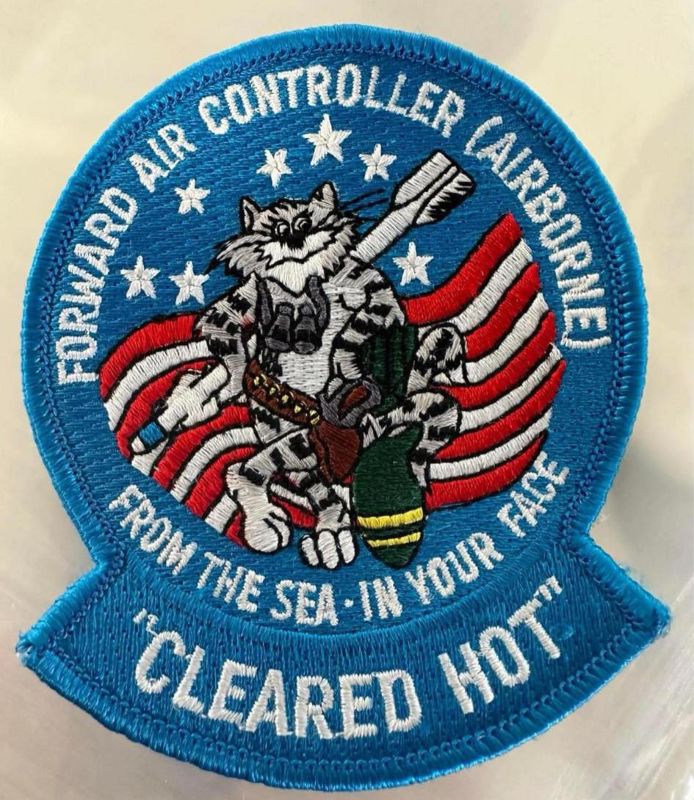The F-14 Tomcat after the Cold War
The iconic F-14 Tomcat was almost benched after the abrupt end to the Cold War which took away the primacy of the fleet air defence role.
However, in its last decade of service, the F-14 adopted a precision strike role with the addition of the LANTIRN targeting pod and the creative adoption of the complementary forward air controller airborne (FAC (A)) mission, ushering in a new chapter of combat successes that were in the forefront of operations over Kosovo, Afghanistan and Iraq right up until the last deployment in 2006.
SEAL JTAC on the F-14 Tomcat and Close Air Support
Andy ‘Senior” Nelson, SEAL Joint Terminal Attack Controller Instructor (JTAC (I)), recalls in the book Half Century, Baby! by David ‘Hey Joe’ Parsons and Mads Bangsø;

‘Some observations from my time as a SEAL JTAC working Close Air Support (CAS), and instructing at NSAWC on Naval Special Warfare (NSW) and JTAC (Joint Terminal Attack Controller) COI. One early spring, I was working with students from the JTAC course during an Air Wing det.
‘On one CAS event, Capt Dave Roy’ Rogers, then NAS Fallon CO and former N5 at NSAWC, asked to bring some visitors out to the range to observe the CAS Event. When he arrived, I briefed the visitors on range safety and the schedule of events. Shortly thereafter a division of F-14s arrived on station armed with live Mk82 and 83 bombs and GBU-16s. The F-14 squadron was hammering everything in sight. All bombs were on the correct target array with TOTs under ten seconds.
‘Capt Rogers (a former A-6 Pilot) was standing next to me. I commented on how accurate the F-14s were with timing and bombing accuracy. His comment back to me was: “For an organization that was designed solely for fleet air defence, and air-to-air, they have wrapped their arms around the CAS mission and mastered it.”
‘Compared to the Navy F/A-18, the F-14s were the most reliable for showing up for CAS in questionable weather. The only exception to this was the USMC F/A-18s Marine Air lives for CAS.’
SEAL JTAC spending a lot of money paying off bets to the F-14 crews

Nelson continues;
‘While briefing of the CAS events during CVW training, the standard or acceptable error for the TOTs was plus or minus ten seconds. I would challenge the aircrews to a plus or minus five seconds on the first pass of each section. The bet was a six-pack of beer or first round at the club. I spent a lot of money paying off bets to the F-14 crews.
‘Navy F-14 FAC (A) aircrews were a welcome boon to special operations. A LANTIRN- equipped F-14 with a FAC (A) trained aircrew was a major force multiplier for small special operations forces. They could do it all from controlling fixed and rotary wing air support to calling in sea and shore based artillery. The only other FAC (A) aircrews that could do that were the USMC F/A-18Ds. However, the shortfall for them was having to use the NITE Hawk pod. I would always tell the Army Special Forces and SEAL operators to always request a Navy FAC (A) for support on combat operations.’
They were all big guys
Nelson concludes;

‘One thing I always observed with the F-14 crews was that they were all big guys usually over 5ft 11in. Most looked like they played football for the Naval Academy. F/A-18 crews were generally 5ft 9in and under. The F-14s and the crews that flew them were the Dick Butkus of the strike fighters… big guys and big powerful planes ready to crush anything that came into their zone.
‘They just looked scary when they were coming at you down low, and most F-14 flight crews looked like they could handle a good bar brawl. The F/A-18 were more of a stiletto of the aircraft and acted like they should be wearing dockers and polo shirts with a cardigan sweater tied around their neck. The USMC F/A-18 aircrews are a different story and not to be confused.’
Half Century, Baby! is published by Mortons Books and is available to order here and here.
For all of you who have got a copy of Half Century, Baby! or those of you who are contemplating a purchase, make sure to put a mark in your calendar on Feb. 22, 2024 when Hey Joe and Mads will be attending a webinar in support of the book. They also would like to use this opportunity to deliver some exciting news, so we hope you will drop by and say hi!
More information will follow!
Photo by LTJG Stephen P. Davis and LCDR Dave Parsons / U.S. Navy

